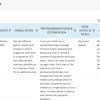Updated to add: The AAC Apps list has been discontinued
It’s October, so it’s International AAC Awareness Month. As a result I thought it was time to blog about one of the most accessed resources on this website – the AAC apps list.
Earlier this year we needed to do some changes to the AAC apps list because it was getting too big for the previous format. Recent comments on the QIAT listserve made me realise that I hadn’t explained those changes – so this blog post will serve as the explanation.
There is now a central page for the AAC apps list which can be accessed from the AAC apps link on the main menu positioned towards the top of every page of the site.
Once you arrive at the main page for the AAC apps list, you’ll see four links to different pages. The first three links are the categories under which the apps are listed.
The three categories are:
- Symbol/Picture apps – These are apps that have symbol based pages but don’t make text-to-speech available to the person who uses AAC.
- Symbol & Text Based apps – These are apps that have symbol pages and make text-to-speech available to the person who uses AAC.
- Text Based apps – These are apps that make text-to-speech available to the person who uses AAC or that have text only communication pages.
The fourth link on the page is a list of Additions and Updates. This will be an ongoing list added to each time I update the list. It will list new apps under “Additions” and apps where the description has been updated (usually due to an app update) under “Updates”.

The above is a screen shot of the top of the Symbol/Picture apps list to help you find the features I mention below.
In all three lists, on the left hand side of the page, between the title of the list and the title row, is a small drop down menu where you can specify how many app entries are shown. The default is 10 but you can increase it as far as 100 if you would like to see more apps at once.
In each list, you can click on any column to sort by that column. Click once to sort the list by that column in ascending order and a second time to sort the list by that column in descending order. The ratings column is a darker blue in the image above because I have just sorted the list by that column.
If you’re looking for a specific app, you have two options. You can type the name of the app into the search box above the “Access Options” column. That will only search the list you’re in. So – if you go to the Symbol/Picture apps list you can type “Sounding Board” into the search box and it will come up.
If you don’t know which list a particular app would be in, you can go to the very top of any page on the site and click on the magnifying glass that appears at the end of the main menu. This will search the whole site for any text – and if an app is included on one of the lists it will tell you which list it is on.
Factors that are taken into consideration when the apps are reviewed and rated are at the bottom of each list.
Hopefully this information is helpful when navigating around the steadily growing AAC apps list. And for those of you who are number minded, here are some AAC apps list numbers to finish:
- The Symbol/Picture apps list is the largest, with 193 apps.
- The Symbol & Text Based apps list is in the middle, with 72 apps.
- The Text Based apps list is the smallest, with 66 apps
- That means there are 333 apps listed in total. This will just keep increasing as time goes on!
- And since I started the apps list in July 2010 (originally located on the Spectronics site) the number of AAC apps has grown at just over 2 per week. The growth has slowed down though, because in July 2012 it was growing at a rate of over 3 per week.
I hope you’ve got some great things planned for International AAC Awareness Month – and please keep spreading the word about the importance of AAC.


Alice
jane